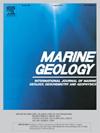贝尔吉卡丘陵漂移的形态沉积演化:与冷水珊瑚丘相关的等高线沉积系统发展的控制因素
IF 2.6
3区 地球科学
Q2 GEOSCIENCES, MULTIDISCIPLINARY
引用次数: 0
摘要
小尺度等高线漂移是大陆边缘的一个重要组成部分,可以记录复杂的海洋过程信息。贝尔吉卡丘陵漂移就是小尺度等高线漂移的一个例子。它是在冷水珊瑚丘(CWC)的影响下形成的,代表了东北大西洋受地中海外流水(MOW)影响的最远等值线表达之一。新的高分辨率伪三维反射地震数据确定了三个不同的演化阶段,每个阶段都与古海洋学的重大变化有关,影响底流强度和沉积物输入。前漂移阶段(上新世-早更新世)与区域性 RD1 侵蚀事件相对应,该事件是由 MOW 在豪猪海湾的重新引入造成的,它创造了一种独特的古地形,将影响随后的所有沉积过程。第二阶段(早更新世-中更新世)是轮廓岩漂移的起始阶段,有两个不同的生长中心,受到地形障碍物(如化学武器丘)的强烈引导。在第三个也是最后一个阶段(中更新世至今),等高线岩漂移是在一个更加稳定但不太活跃的环境下发展起来的,其特点是更加连续和丘状的增生分层。等高线漂移的最后阶段与中更新世过渡时期有关,与 MOW 有关的底流和沉积物输入在空间上有所减少。这种漂移的时空演变表明,其现今的形态受初始生长位置的控制。不断演变的堑壕形态表明,在漂流演变过程中,底流强度通常会增加。这项研究为我们提供了一个重要范例,有助于增进我们对不同海洋环境中较小规模等高线系统复杂性的了解。本文章由计算机程序翻译,如有差异,请以英文原文为准。
Morphosedimentary evolution of the Belgica Mound Drift: Controls on contourite depositional system development in association with cold-water coral mounds
Small-scale contourite drift is an important component of continental margins that can record information about complex oceanographic processes. The Belgica Mound Drift is one example of a small-scale contourite drift. It is formed under the influence of cold-water coral (CWC) mounds and represents one of the most distal contouritic expressions influenced by the Mediterranean Outflow Water (MOW) in the NE Atlantic Ocean. Three distinct evolutionary stages have been identified from new high-resolution pseudo-3D reflection seismic data, each associated with a significant change in paleoceanography, affecting both bottom-current intensity and sediment input. The pre-drift stage (Pliocene–Early Pleistocene) corresponds to the regional RD1 erosive event, which was caused by the reintroduction of the MOW in the Porcupine Seabight, creating a distinct paleotopography that will influence all ensuing sedimentary processes. The second stage (Early Pleistocene–Middle Pleistocene) is the contourite drift inception in two distinct centres of growth, strongly steered by topographic obstacles such as the CWC mounds. During the third and final stage (Middle Pleistocene–present day), the contourite drift is developed under a more stable but less dynamic environment, characterised by more continuous and mounded aggradational stratification. The final stage of the contourite drift is related to the Middle Pleistocene Transition, with a spatially variable reduction in the MOW-related bottom currents and sediment input. The spatial and temporal evolution of this drift shows that its present-day morphology is controlled by the location of initial growth. Evolving moat morphology indicates that the intensity of the bottom currents generally increases during the drift evolution.
This research presents a crucial paradigm for advancing our knowledge of elucidating the complexities of smaller-sized contourite systems in diverse oceanic environments.
求助全文
通过发布文献求助,成功后即可免费获取论文全文。
去求助
来源期刊

Marine Geology
地学-地球科学综合
CiteScore
6.10
自引率
6.90%
发文量
175
审稿时长
21.9 weeks
期刊介绍:
Marine Geology is the premier international journal on marine geological processes in the broadest sense. We seek papers that are comprehensive, interdisciplinary and synthetic that will be lasting contributions to the field. Although most papers are based on regional studies, they must demonstrate new findings of international significance. We accept papers on subjects as diverse as seafloor hydrothermal systems, beach dynamics, early diagenesis, microbiological studies in sediments, palaeoclimate studies and geophysical studies of the seabed. We encourage papers that address emerging new fields, for example the influence of anthropogenic processes on coastal/marine geology and coastal/marine geoarchaeology. We insist that the papers are concerned with the marine realm and that they deal with geology: with rocks, sediments, and physical and chemical processes affecting them. Papers should address scientific hypotheses: highly descriptive data compilations or papers that deal only with marine management and risk assessment should be submitted to other journals. Papers on laboratory or modelling studies must demonstrate direct relevance to marine processes or deposits. The primary criteria for acceptance of papers is that the science is of high quality, novel, significant, and of broad international interest.
 求助内容:
求助内容: 应助结果提醒方式:
应助结果提醒方式:


